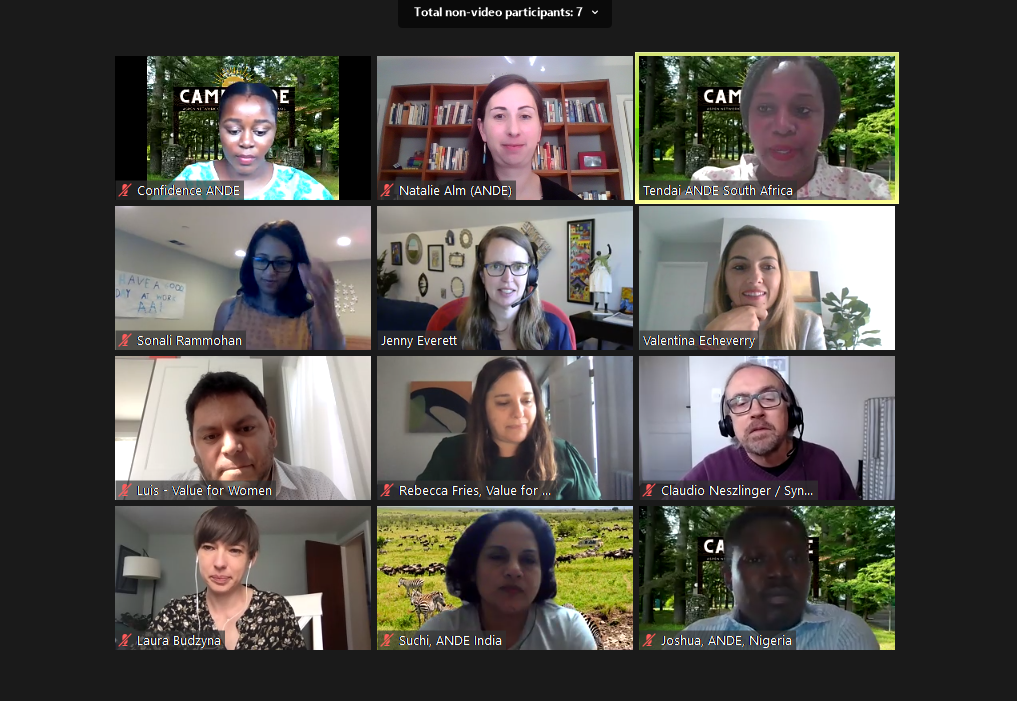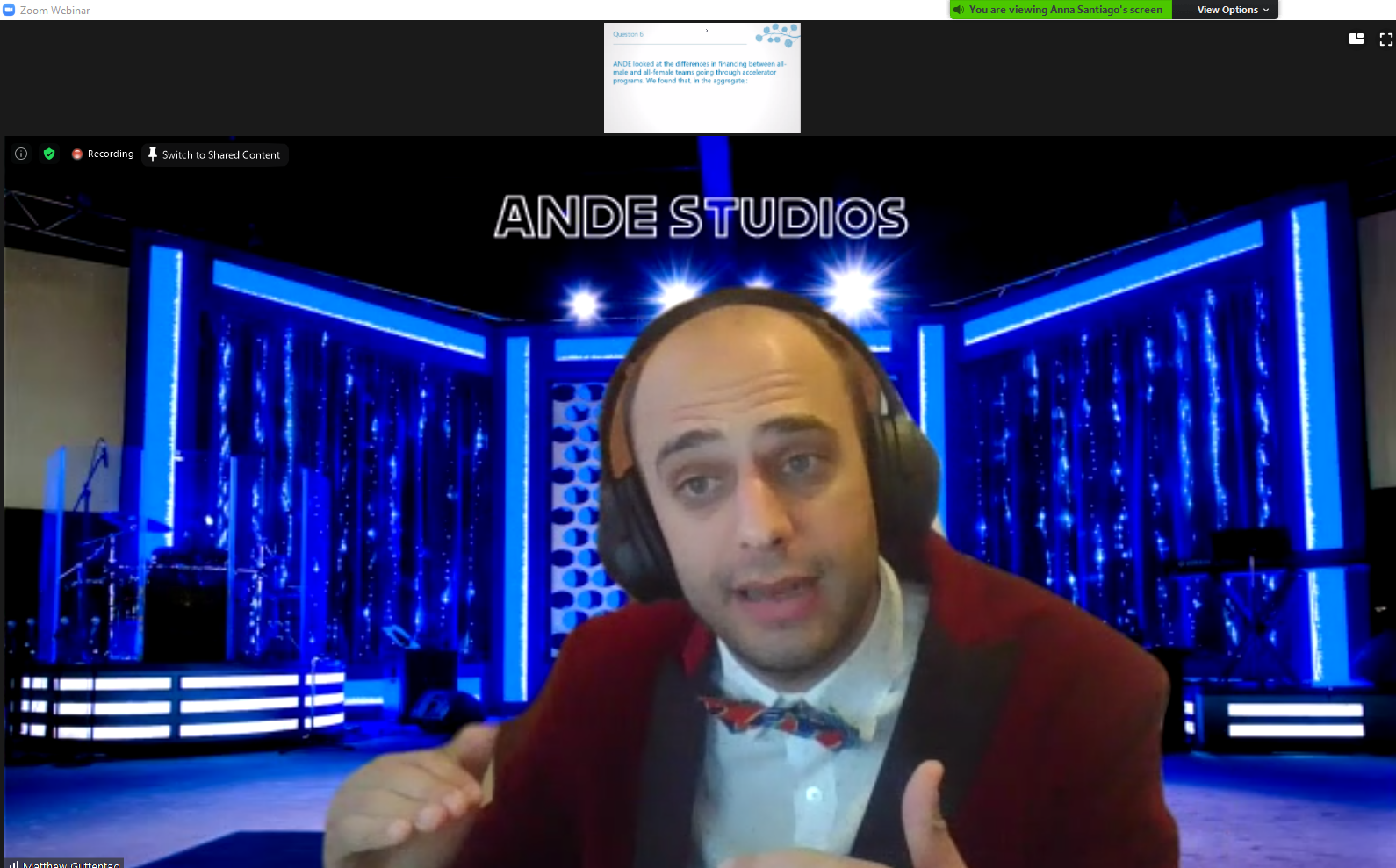We never expected to end up with a virtual conference in our hands. ANDE has been hosting our flagship Annual Conference for a decade, and the in-person opportunities for connecting and learning have always been a highlight for our members. But in late March, as COVID-19 caused countries to close borders and impose travel restrictions, it became clear that hosting an in-person conference was no longer a responsible option.
The ANDE team had a lot of questions on how best to run a virtual conference. Beyond the logistical considerations, we put a lot of thought into how to translate our usual Annual Conference “vibe” to the screen — without coffee breaks, breakout brainstorming huddles, or the you-either-love-it-or-hate-it karaoke tradition. At the time, every other organization was also scrambling to adapt, so there were few established best practices to point to. We therefore started out on the journey fairly blindly and learned a few lessons along the way.
- Leverage staff capacity from across the organization.
Every year ANDE forms a core event team from its DC-based staff to lead the annual conference. This always makes sense as the team has a lot of interactions with service providers in the DC area. A virtual conference presented an opportunity to bring on board chapter-based staff to help coordinate the conference. This added a new perspective to the conference and allowed ANDE staff and members across multiple time zones to have someone available respond to their inquiries at all times. It was a great professional development opportunity for staff, helping to build staff capacity more broadly. Finally, it helped staff who are usually on different teams’ bond and learn from each other.
2. Bring in the experts to do virtual facilitation justice.
Transitioning to a virtual conference gave ANDE an opportunity to assess existing skills and identify gaps within the team. We decided to engage Lizard Brain, a network of facilitators, consultants, coaches, and trainers, to train selected team members on virtual facilitation. We had great success with virtual icebreakers, creating a mood through music during transitions, making good use of Zoom polls to keep the audience engaged and rather than the typical conference brainstorming with poster board and stickers, we used well-organized Google Docs to engage participants in thematic breakout sessions in brainstorming solutions to challenges in the SGB sector
We also worked with a Georgetown University cohort taking an executive course on virtual facilitation. Through their design challenge class, they helped ANDE redesign the conference. For instance, we introduced thematic areas of focus and asset mapping sessions facilitated by some of the cohort members to promote collaborative action amongst ANDE members beyond the event.
3. Experiment with scheduling.
Given that ANDE works across the Americas, Africa, and Asia, we decided to organize the conference into two core blocks each day: 8–11 AM and 6–9:30 PM ET. This allowed people to join at hours that worked best for their schedule. The general structure was the same between the two blocks, though the content was different. This format also gave ANDE a chance to learn from the morning session and incorporate the feedback into the evening agenda. We did find that turnout in the evening session was lower than expected, so we expect to keep experimenting with the scheduling and agenda for future events.
4. Keep the technology simple and familiar.
When we started planning for the conference, we had grand plans on the type of technology we wanted to leverage. As we got closer to the conference, we learned that it was important to stick to technology that our staff and ANDE members are most familiar with. After all, why fix what is not broken?
It may seem obvious, but dry runs were critical before going live. We had procured a seemingly perfect platform to use for the speed networking sessions, only to learn that attendees couldn’t use this platform without creating a google account. We thus dropped it and stuck with more the user-friendly Zoom, which we were already using for other conference sessions. Sending pairs into breakout rooms for speed networking ended up working great — maybe even better than in person, when you can cut off lingering conversations with the click of a mouse!

5. Have a back-up.
With technology, anything could happen. The keynote speaker could drop off mid-sentence or the moderator’s power could go off right before a session starts. Everyone with a formal role at the conference had an understudy or backup with enough resources to step in and support a session if need be. All the plenaries had more than one lead discussant, and in some special cases, sessions were prerecorded.
6. Have fun with it!
While deciding to pivot online, we did not want to lose the fun, let-your-hair down moments that organically happen during our in-person conferences. We started by identifying a theme, “Camp ANDE,” as a nod to the spirited, community aspects we wanted to capture. Throughout the conference, we had members host “campfire activities,” where they shared what they were passionate about. Topics ranged from practicing mindfulness to how to build a tiny home!
Our emcees really took this idea of having fun to heart and kicked off all plenary sessions with a dance party. ANDE staff compiled a playlist with songs from around the world, so a Nigerian pop song might be followed by a song sung in Portuguese. The playlist was a hit and we found it a great way to welcome people to each session.

All in all, in retrospect what started as a fuzzy journey became a rewarding one! Staff and participants aren’t complaining about jet lag. More importantly, the virtual nature of this year’s conference made the event more accessible to many ANDE members (and even staff), especially from smaller organizations, that would typically not be able to afford to attend the conference.
Even before the dust settles, some ANDE staff are already looking at the possibility of offering some kind of hybrid conference model in the future, to take advantage of some of the benefits of going virtual. While we don’t know exactly what things will look like in 2021, we do look forward to engaging again next year for another one-of-a-kind ANDE Annual Conference.
